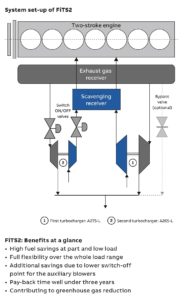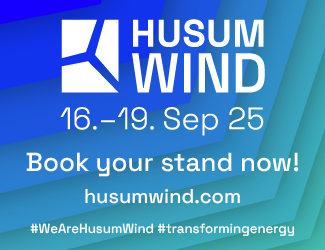ABB Turbocharging took the chance during global trade show Marintec in China to launch the Flexible integrated Turbocharging System for Two-Stroke Engines (FiTS2).
The new sequential turbocharging system is described as allowing maximum fuel savings for two-stroke engines at part[ds_preview] and low load, »and at the same time maintaining the flexibility to go to full engine output immediately«. ABB add in a statement, this offers significant long-term economic benefits for vessel operators and charterers with potential for fuel savings of up to three percent, depending on load profile.
»From an operator’s or charterer’s perspective, FiTS2 efficiency benefits will enable major cost reductions. Considering for example a typical current fuel bill of 3 to 4 mill. $ per year for very large crude oil carriers, FiTS2 has potential to provide fuel cost savings of up to 100,000 $ per year, compared with levels typically achievable using conventional turbocharging systems. Big savings are also possible for other vessel types, e.g. for container vessels and can amount to 1 mill. $ or more over 10 years. The payback of initial costs can be less than two years, making the FiTS2 solution very attractive.«
Joachim Bremer, Head of Product Line Low-Speed, ABB Turbocharging.
It has been developed in close collaboration with low-speed two-stroke engine designer, Winterthur Gas & Diesel Ltd. (WinGD), which has developed a special tuning for FiTS2. Additional abatement technologies like SCR or EGR can be used to comply with IMO Tier III NOx emissions and will not greatly affect the system while still delivering fuel saving benefits, the company said.
Technology

To optimize engine efficiency via improved turbocharging in low and part load, the engine runs in lower loads with only one turbocharger in operation, whereas at higher loads (typically above 50 to 60 percent engine load) two turbochargers operate simultaneously. The same principle is applied for very large engines – with FiTS2 they will run with two turbochargers in lower loads and with all three turbochargers for higher load operation. ABB explained, the specially designed cut-off valves for the FiTS2 system are flow-optimized and integrated with the turbocharger casings, ensuring a compact and lean design. »Furthermore, the valves can be operated rapidly and automatically under load, without interrupting operation of the engine up to full load.«
Cut out of one turbocharger for lower engine loads leads to higher scavenging air pressure, increasing the compression ratio and firing pressure optimized by special tuning of FiTS2. The result is enhanced engine efficiency and lower specific fuel consumption while remaining compliant with emission regulations.
»An additional benefit comes from the possibility to switch off the electrically-powered auxiliary blowers at 25 % engine load, instead of around 35 percent load. This enables additional savings via reduced power consumption and lower blower maintenance costs due to significantly fewer operating hours«, it was said.













